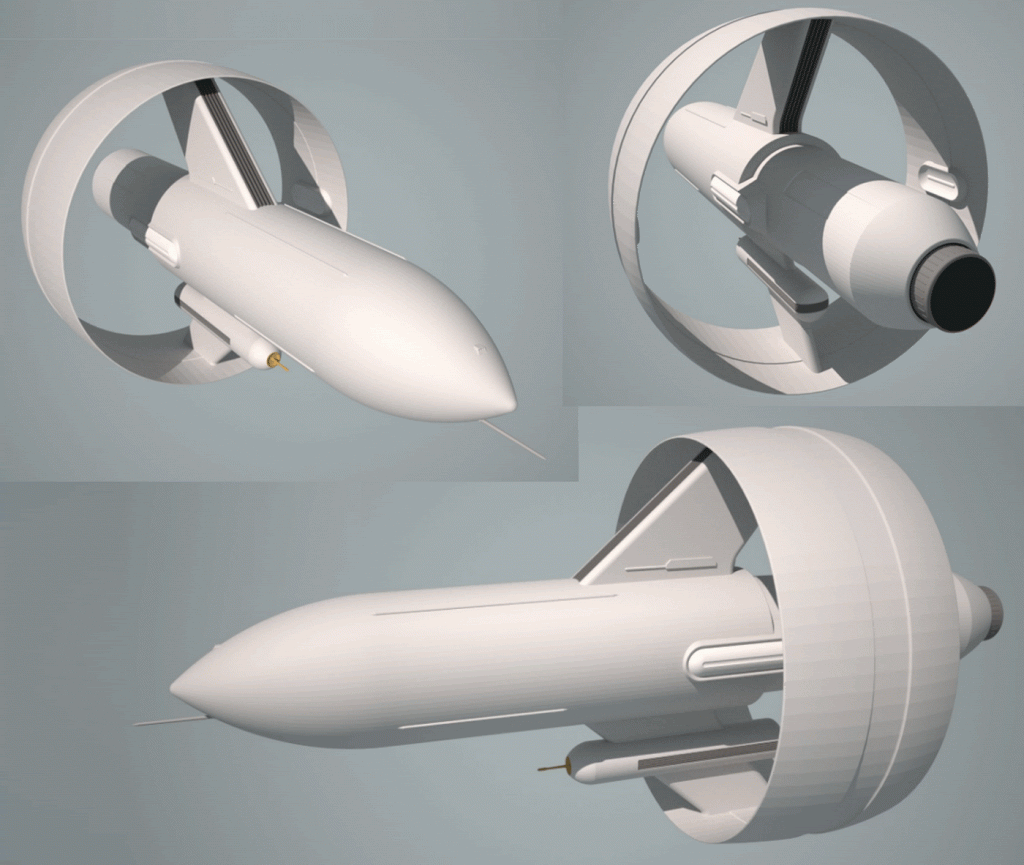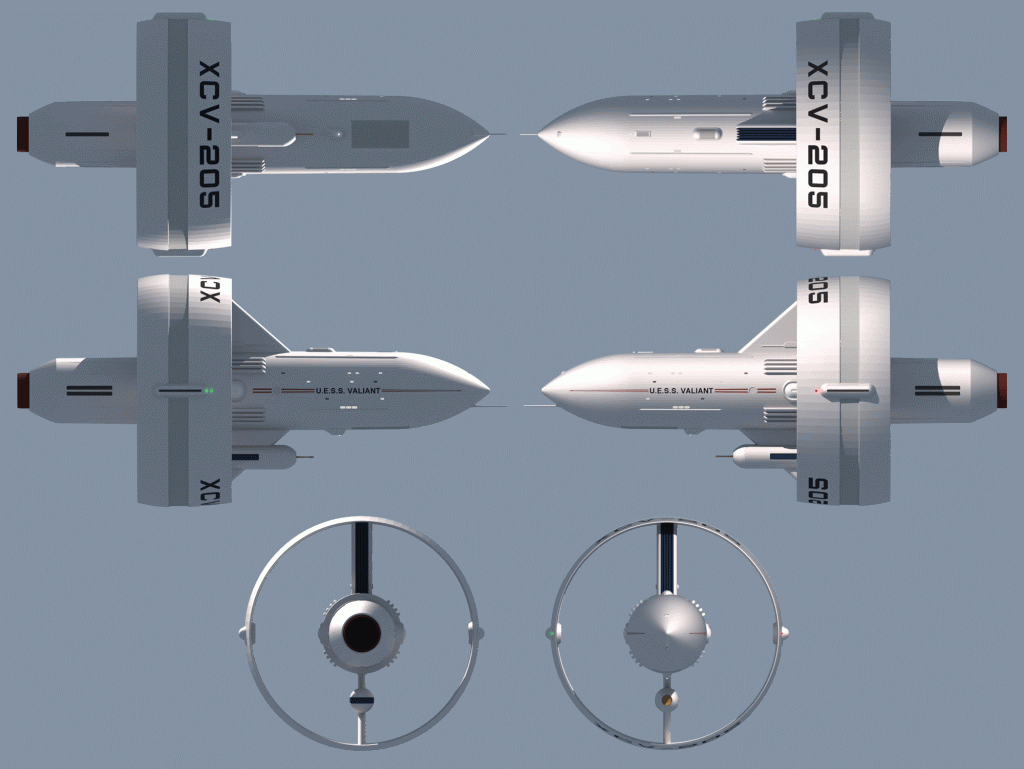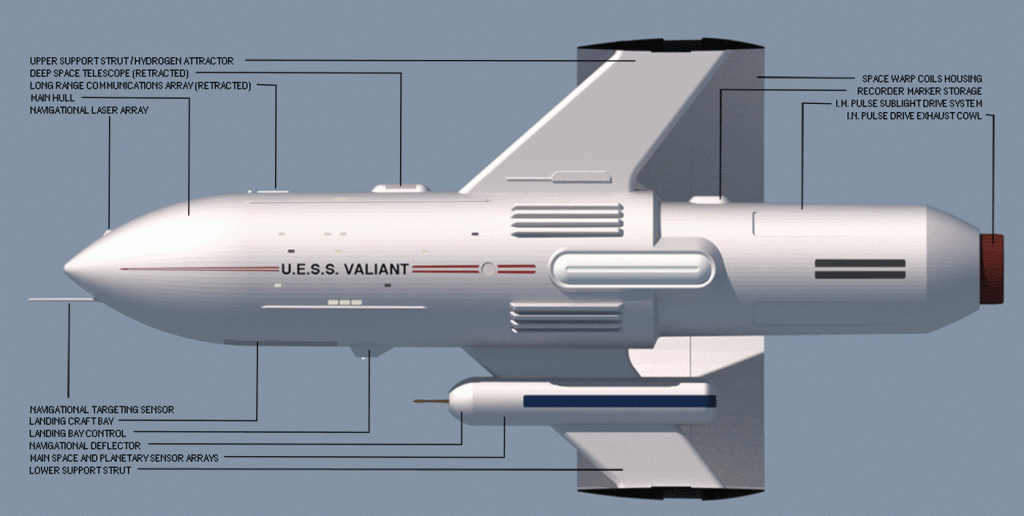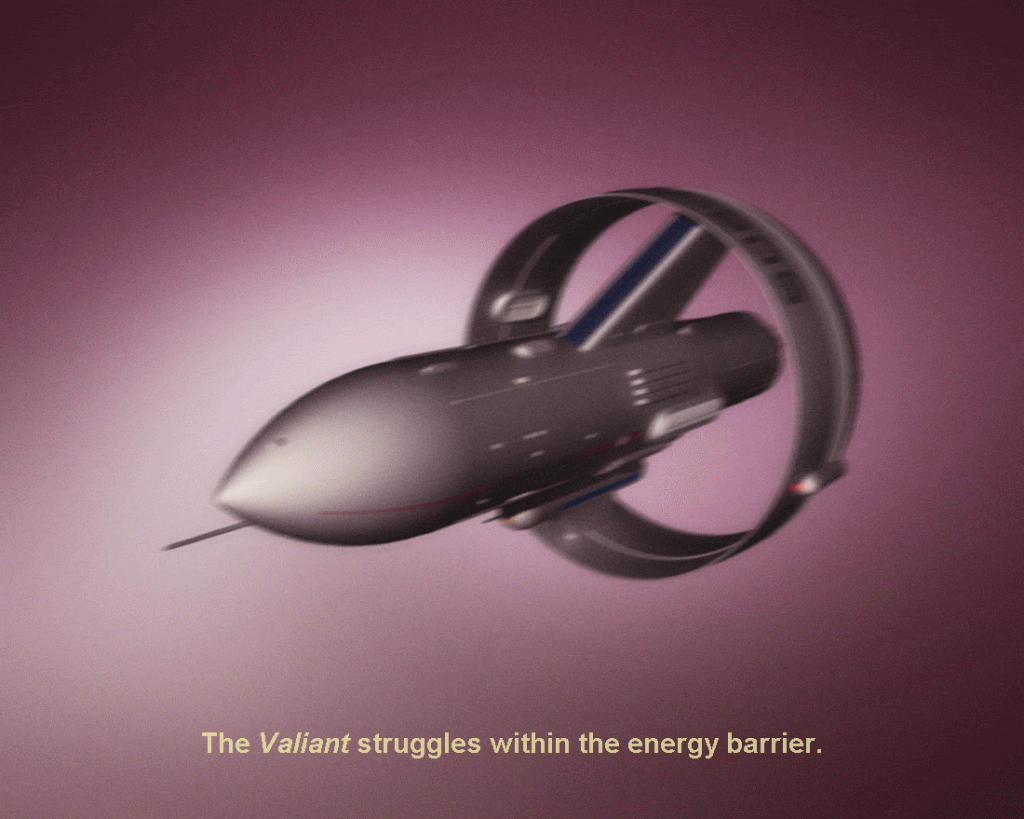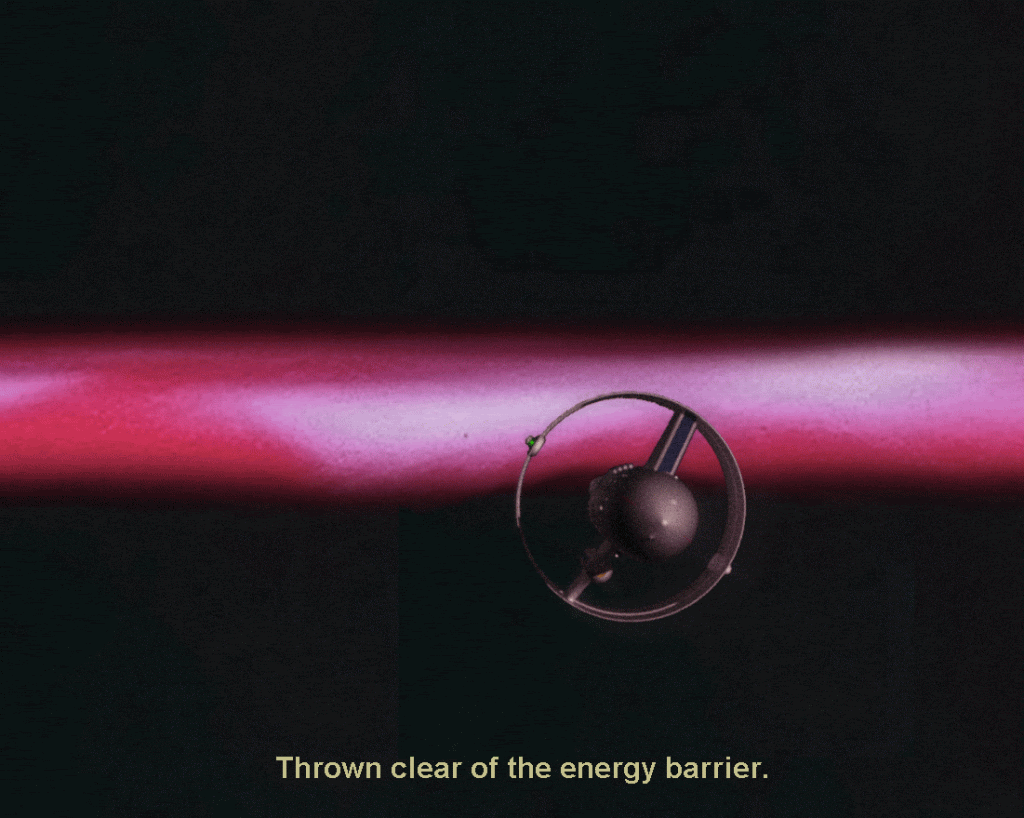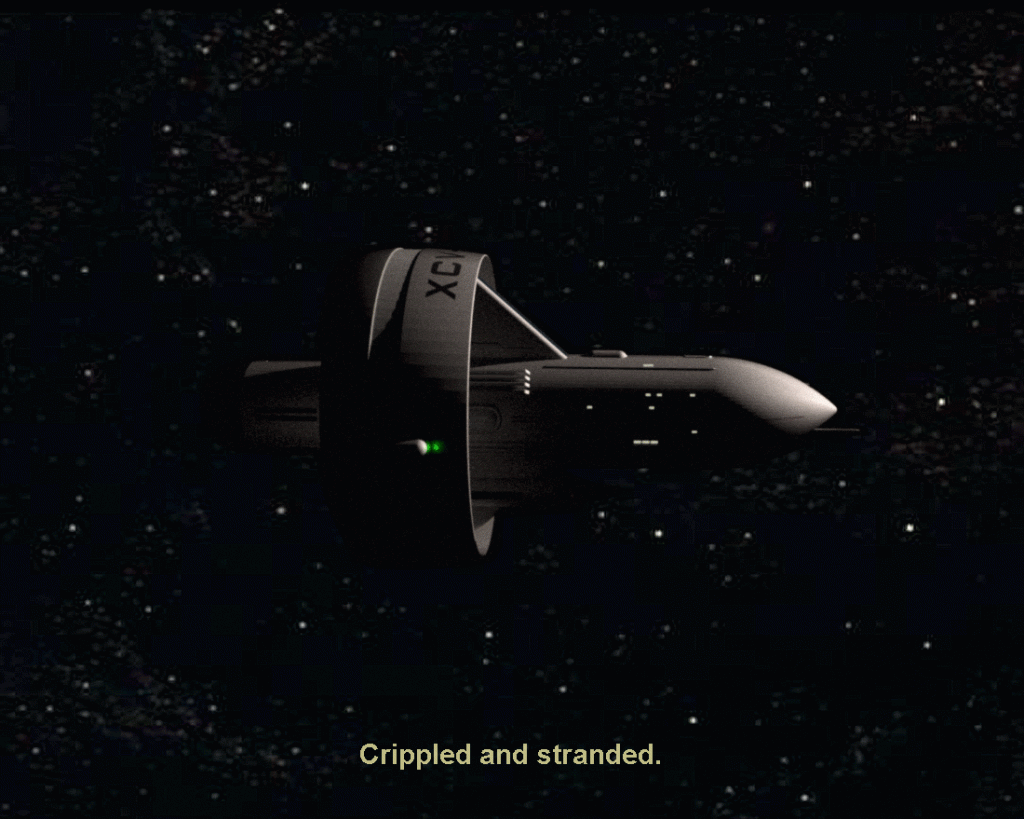-
Welcome! The TrekBBS is the number one place to chat about Star Trek with like-minded fans.
If you are not already a member then please register an account and join in the discussion!
You are using an out of date browser. It may not display this or other websites correctly.
You should upgrade or use an alternative browser.
You should upgrade or use an alternative browser.
The Valiant never seen....
- Thread starter Warped9
- Start date
^^ No, no atmospheric maneuvers. The DY-100 also has an even more pointed bow and it was a strictly sublight ship.
Mm. True enough, I suppose.
This Valiant is essentially a fast relativistic ship design adapted to having a space warp drive setup fitted to it. Hence the pointed nose for a ship that can accelerate to near light speed. At those speeds you quickly learn that space is hardly empty vacuum at all. You therefore need such a shape to help cleave through the interstellar medium much as a jet aircraft has a pointed nose.
My thinking behind this Valiant.
During the second pilot MJ might not have given any thought to what the Valiant looked like if it wasn't called for in the script. That could have been different if they had considered putting an image of the ship on one of Spock's overhead displays (something that could have been done in TOS-R).
The only tiny visual clue we have about that era in TOS is the DY100 from "Space Seed." That design supposedly predates the Valiant by at least fifty years and maybe even seventy years. The DY100 design is obviously way more advanced than any real spacecraft we've ever had even presently. That speaks of space programs that didn't get derailed after Apollo.
So, to me, that means the Valiant shouldn't look too much projected from what we have now. Rather I'd look at references like The Spaceship Handbook and The Saucer Fleet as well as other similar references and try to springboard a design from there. This material looks at the fictional and proposed designs for spacecraft from the 1920s to 1960s. The key difference, of course, is your design is meant to be an interstellar rather than strictly in-system vehicle and so you adapt with that in mind.
You could also look at some of MJ's early sketches when he was trying to get a handle on a direction for the Enterprise. However, I don't know how much of that material survives or is available. I think I have seen some things online that weren't included in the Star Trek Sketchbook.
I'd also be inclined to ignore most if not all references from post TOS in terms of distancing yourself from more contemporary Trek influences (particularly ENT). I think that's a more likely path to work out a design that looks and feels more consistent with TOS' style.
My two cents.
Oh, for what it's worth here's my offhand conception of the Valiant from some years ago.
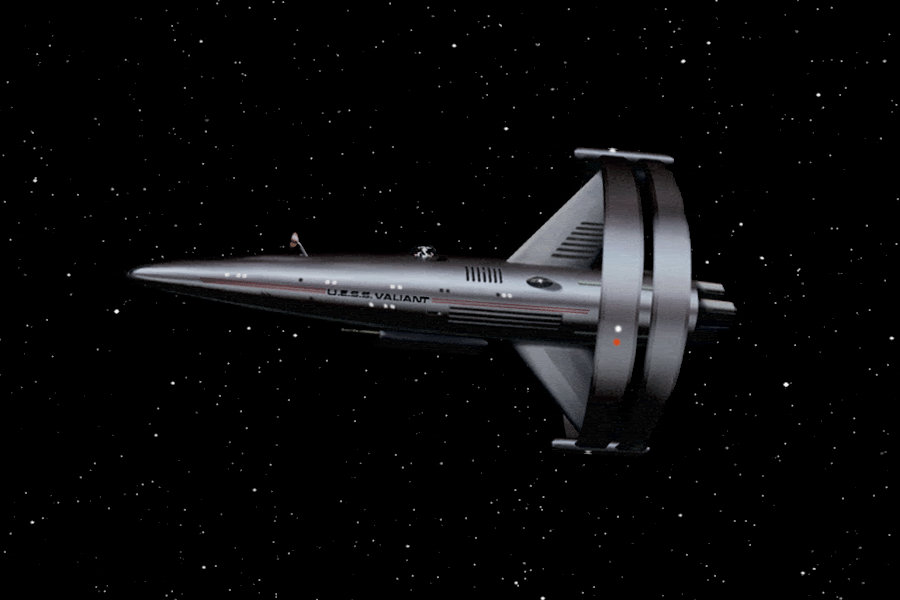
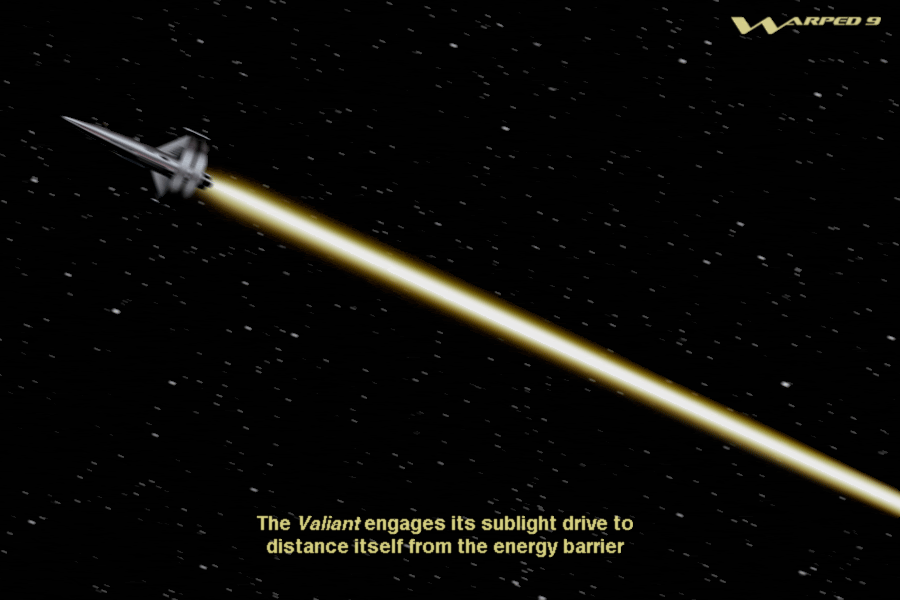
I essentially took the hull of the spaceship Luna from the 1950 film Destination: Moon and started playing with it in Photoshop. At the time I didn't think too much about it beyond that. My basic idea was the Valiant was initially a fast relativistic ship that was fitted with an early form of space warp drive. I like the name used in the Trek novel Federation where it's referred to as a superimpeller. My thinking was that in the early years of interstellar starflight different configurations were experimented with to find an optimal design rather than assuming two nacelles were always there from the beginning and throughout until the (Trek) present.
This and the other thread has gotten me thinking...and sketching. And so I think I'm going to tackle a more serious effort to design this.
My sources: TOS, TAS and TMP sources as well as period (1920s to 1970s) speculation of future spacecraft both real world and fictional. The key for me is trying to put my mindset back into the thinking of that era.
The only concrete onscreen visual clues we have are the DY-100 class ships of Trek's 1990s and the ringship seen in TMP from approximately Trek's late 21st to early 22nd century.
What we know is that sleeper ships were used for interplanetary travel (within the solar system) until 2018 when some sort of advanced propulsion became available and that most likely wasn't FTL. We know Zefram Cochrane developed a form of space warp sometime around Trek's mid 21st century.
What we don't know---and it's rather irrelevant---is what kind of mission the Valiant was on, how long it was operational and how long it was contact with Earth, and finally how and when it ended up at the galaxy's edge. We do know the ship was classified as a "galactic survey cruiser." That does suggest extended range exploration, at least within limits of the era.
My bad. I recall James Blish including that in his adaptation of the episode where he references the ship's name the words "galactic survey cruiser" on the outside of the recorder marker, and yet looking at screencaps you can't see anything other than S.S. Valiant on the top of the device. I'd always thought Blish was working from earlier script drafts that could have held information that didn't always make it onscreen. I and many other fans have thought this for so long we might have accepted it as self-evident.Was there actually some marking on the Valiant's recorder-marker that said "galactic survey cruiser"? I don't remember that.
That said it does make a measure of sense given the Valiant being so far out in deep space and then eventually at the galaxy's edge even if it was an accident.
As long as you are trying to figure out something Jefferies might have bought into-- reflecting his design cues, etc -- then feel free to keep your speculations and art in this thread, Warped.
What do we know or at least what can we gather from what we've seen of his work from that time?
The DY-100 looks to be a utilitarian design and Jefferies did say (I'm sure I read it somewhere) it was meant to be some sort of freighter type craft that had been converted into a sleeper ship. From that it's possible to envision an actual sleeper ship was something more sophisticated and Khan and his followers might have simply adapted what they could get hold of for their purposes. If you really think about this it would entail a lot of effort to convert a cargo vehicle into one intended to carry about 70-80 humans in stasis on a decades and perhaps centuries long voyage. Since it was said that sleeper ships were meant solely for interplanetary voyages that would last only months then Khan and his group should have know it was a long shot for them to survive decades to centuries. Maybe it was simply easier to steal a cargo ship than an actual interplanetary transport designed for human transport. And, no, I haven't read any of the Khan novels.
From what we can see of the Botany Bay the DY-100 it looks like cargo modules are supposed to fit all around the central section and yet at least a couple are missing. Yeah, it looks cooler that way, but one could argue Khan and company perhaps had to make a hasty escape before the ship was completely fitted out. The fact that the ship looks like it has a sail or conning tower much like a submarine could well be coincidental as that part of the ship might be mostly airlocks and/or assorted radar systems or whatever.
There is one other interesting thing, too. When Kirk and his landing party board the Botany Bay they find a gravity environment in place. Yeah, sure, they couldn't afford to show a zero-g environment, but it means the Enterprise crew have either advanced magnetic boots that look just like regular service boots or there actually was at least a minimal artificial gravity environment aboard the Botany Bay that kicked in when the presence of the Enterprise was detected. And since the Enterprise crew aren't showing much care in how they move aboard I think it argues that Earth science in Trek's 1990s had somehow developed at least a minimal form of artificial gravity.
If you have artificial gravity and can refine it over the years then it could also help in terms of better acceleration for your spacecraft because you won't have to limit yourself to only one-g accelerations and decelerations (for the crew's benefit). This in tandem with early yet advancing inertial systems and you're well on your way to developing better interstellar starships.
The 1950s and '60s were indeed an optimistic time in many respects if they could speculate having a vehicle like the DY-100 within the next thirty years or so. In the real world there is certainly nothing close to that. Fortunately we're not completely limited solely to the real world in Star Trek's universe.
In 2018 we get a more advanced propulsion system that makes sleeper ships obsolete practically overnight at least for interplanetary travel. Impulse? well even a chemical rocket is actually a form of impulse engine, but obviously we're talking about something far more powerful and comparatively more compact than a chemical rocket motor. Yet a sleeper ship could still have a use if someone wants to gamble on an interstellar voyage given you still don't have a FTL drive. A fast relativistic engine system could be of value because the time dilation effect would mean established stasis systems still only have to keep the crews alive for only months rather than years. This could work to get to the nearest star systems. This is also where the question of where Zafram Cochrane really comes from kicks in.
If a ship was sent to Alpha Centauri and a colony begun there then Cochrane could be either one of the early explorer/settlers or one of the first born there. Later developing a fantastic advancement such as a superluminal drive and he could well be remembered as Zefram Cochrane of Alpha Centauri.
Also we don't really know if Cochrane simply developed the mathematics and formula for achieving a working space warp or if he built the first working prototype founded on work that came before him. The latter would seem most likely because like in the real world a lot of theoretical science goes into an idea for years or decades before someone finds a way to actually make it work when the level of science and technology makes it possible. It's just not plausible that Cochrane did it all from scratch all by himself. It makes more sense that a lot of theoretical work had been done already before Cochrane takes a shot at it. But that part of the story isn't really relevant to my goal of designing an early galactic survey cruiser. What is relevant is that Cochrane's space warp comes online sometime in the mid 21st century, sometime in the 2060s-2070s I think. So for about forty years we're getting around with ships that aren't FTL but they get us to the nearby star systems with relative ease. Exploration beyond the solar system could have gotten started.
This leads us to the Valiant. Could the Valiant have been one of those early pre FTL exploration ships that later found itself refitted into one of the first space warp ships and rather grandiosely re-classed as a "galactic survey cruiser?" Or was it designed as a space warp craft from the onset?
The earliest FTL ship in Star Trek we get a glimpse of is the ringship on the refit Enterprise's recreation room wall. Oh, look, it ain't got no familiar warp nacelles! That doesn't mean there weren't any in the ringship's era, but it evidently became a historically significant vessel and possibly representative of the best science of the its time. And while the central section is certainly more elaborate than a DY-100's it still retains that somewhat cylindrical shape overall encircled by those massive rings...or space warp coils.
A small side note here. After being seen in TMP in 1979 the ringship was believed by many to have been some form of early interstellar starliner despite the fact that Jefferies initially designed it as an early exploration type craft for a possible series idea of Roddenberry's but which never got off the ground. To my eyes unless the thing is supposed to be truly massive it doesn't look like it could be much of a passenger liner. Indeed unless you've got a well established number of developed colonies going as well as other exotic ports of call then an interstellar starliner likely isn't of much use. No it makes more sense the ringship Enterprise was more likely an early exploratory ship.
In the early days of FTL starflight a number of concepts might have been tried to find the optimal configuration. There could well have been some promising approaches that ultimately didn't pay off and/or were surpassed by better and/or more practical solutions. And who is to say those massive rings weren't eventually made ever smaller until they could fit within the confines of a familiar nacelle. Maybe that's where the TAS Bonaventure comes in. Scotty says it was the first ship with warp drive, but maybe what he really meant was it was the first ship with the now familiar configuration of warp drive seen throughout the Federation and Starfleet.
This all leads to my conception of the Valiant. Something between the DY-100 from some 70-80 years previously and the ringship that will come about 30-50 some years later. Basically a somewhat cylindrical central section (with add-ons) encircled by large rings somewhere about midship and a comparatively hefty looking impulse drive extending back.The ship would have artificial gravity simply because the DY-100 appears to have had it as well several decades earlier. I think the ship should be capable of fast relativistic travel in the event of a failure of the space warp system.
What can it look like? Well, I'll get back to sketching it out first...
I still quite like this initial idea, but I'm going to depart from it although the basic concept holds.
Essentially my idea is to take the bullet shape of Hermann Oberth's Modell E rocket or his version known as the spaceship Friedeseen in Woman In The Moon and turn it on its side. Eliminate the box fins except one which is tweaked and adapted into the main support for the two massive ring-coils fixed a bit aft of mid ship. There will be additional support for the rings from a different looking lower strut. Aftward will be hefty looking sunlight or impulse drive. The impulse section and the ring support and rings will look a bit less evolved than that seen on the ringship Enterprise. Then it's a matter of adding detail.
Part of how I like to design such things is to imagine a story being played out with the ship, envisioning it in the pages of a book or scenes from a film or television episode.
Here is the beginning of what I'm thinking. I don't know how detailed I'll get yet, but once I've got the overall design established I'll do a quick 3D model of it. I still quite like the more rocketship shape of my Photoshop effort, but this version looks more visually connected to the type of ships that might have preceded it all the way back to the DY-100s. I'm also thinking that the rings can be jettisoned if the space warp drive became irreparably inoperative. In that event the ship would have to resort to the sublight drive and the ring system would be so much deadweight.
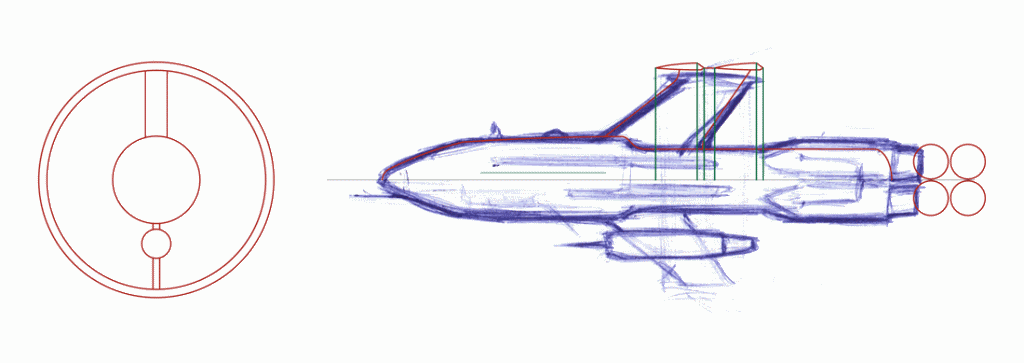
Backstory:
The Valiant was one of a number of designs on the drawing boards and slated for construction when Cochrane went public with his space warp discovery. Once the mathematics of Cochrane's theory appeared sound there was no shortage of interest in his work and it was rather easily fast-tracked to get a prototype into development. Within only a few years Cochrane's prototype began successful testing flights with only relatively minor glitches along the way. Yeah, I know this completely ignores FC and ENT, but I'm interested in a more credible backstory.
Starship designs including the Valiant had been put on hold waiting to see if Cochrane's superimpeller space warp design proved successful. When it did prove successful a number of other prototypes began testing to study how well the design could be applied in practical terms. This, of course, included more powerful versions of the design as well as variations using Cochrane's theory as the starting point.
The Valiant's program was reconsidered and it's design adapted to fit one of the space warp designs that seemed among the most promising and so far one of the most successful. What the ring design seemed to lack in the promise of sheer possible speeds attainable it made up for by being more stable in operation. Construction of the Valiant in Earth orbit began less than ten years after the first successful test flights of Cochrane's prototype.
It took four years to complete the Valiant followed by two years of space trials before she was commissioned into service with U.E.S.P.A. During her redesign she was re-classed and pitched (rather grandiosely) to the public as a Galactic Survey Cruiser fully capable of exploring deep space and back. Before she was even commissioned a sister ship had already begun construction with a number of others already in planning (her sister ship, the Intrepid, would launch two years later).
The Valiant was not the first FTL ship to see service, but she was (at the time) the largest and most advanced. Whereas previous and other concurrent ships were somewhat limited in their function the Valiant was designed for extended 2-3 year voyages before requiring refuelling and replenishing of supplies. The Valiant would return from two deep space surveys before disappearing without explanation on her third voyage. Her sister ship, Intrepid, continued throughout a long service life.
Although an incredible achievement and quite a sophisticated construct for its time the Valiant, like many early FTL ships, wasn't really well suited for deep space exploration. Earth had not yet discovered the genuine hazards of deep space starlight. All manner of unknown phenomenon were waiting in the dark beyond the familiar space of Sol and the near star systems. Although technically sophisticated the early star drives (both FTL and sublight) as well as many onboard systems were not yet robust enough for many of the hazards encountered. Many flight personnel had really no idea what they could encounter. Yet these early spacers were often as undaunted as the first astronauts of the previous century that had dared to climb into little more than tin cans to step upon the Moon, Mars and other solar bodies.
Besides engineering that wasn't really yet robust enough for many unexpected hazards the first ships also ventured forth unarmed and with no real defensive measures to speak of. They were easy prey for predators like the Kzinti and others. And it would be another century before the development and widespread use of subspace radio, without which ships had no way to call for help or to give warning back home of what they encountered. Occasionally ship recorder markers were found or garbled messages received months to years or even decades after the fact. But it was aboard these early ships that humanity soon began to encounter other sentient races both friendly and hostile.
Overall I rather like how this is coming together. I think it has an overall look that could fit into Jefferies' general approach. I'm trying to add a decent measure of detail without going overboard on it so the end result looks like it could be convincingly pre TOS just as the Botany Bay was. Mind you the BB wasn't all that detailed, but then it didn't have to be since its appearances onscreen were rather brief and its weathering could hide a lack of overall detail. With the Valiant I'm treating it almost as if it were to be a "hero" ship with a fair amount if screen time. In actuality, though, if it were to have made an appearance in WNMHGB it likely would have been brief and unclear such as appearing on one of Spock's overhead screens.
Candidly I've never really cared for the Star Trek Chronology's version of the Valiant. It just doesn't work for me and doesn't look like something that we might have seen in TOS. He'll, I don't think it looks as good as the Botany Bay.
I think I've taken this as far as I can.
I think the silvery alloy look gives this something of a '50's era retro look to it even though the design isn't something we would likely have seen in '50's era sci-fi. I think it does look suitably more rudimentary than the TOS era yet certainly more advanced than the DY-100 series. I think it also looks suitably more devolved than the ringship Enterprise which will come some decades later.
Well a pro also has deadlines. That can affect the end result. A pro is also recognized because of a body of work and to deliver results within a projected and agreed upon time frame.A "professional" gets paid.
And doesn't do anything nearly as well. That's the difference. To me, that's all the difference.
You forgot one thing, the pro has an employer. Someone who might not be able to draw better than a stick figure but doesn't want the best effort of the artist enless it fits the employer's vision. I think this is a source of some quality reduction, the studio's effort to make sure that the end product is profitable. Therefore, the first effort can be well within a deadline and rejected because it wasn't something enough.
^^ No, I didn't forget that. I don't think that it's really relevant. I think the real distinction is that one is considered a pro because they're recognized for their work and has been successful and paid. One can have all kinds of talent (in any field) but until you're recognized and paid for it your ability doesn't matter.
Last edited:
^^ No, I didn't forget that. I don't think that it's really relevant. I think the real distinction is that one is considered a pro because they're recognized for their work and has been successful and paid. One can have all kinds of talent (in any field) but until you're recognized and paid for it your ability doesn't matter.
Well what it seems like he's saying is that even if you're paid for it, your aesthetic abilities and sensabilities and and visionary talent doesn't matter either unless you call the ship something else and write you're own original franchise setting and premise and also happen to be a producer with enough clout and able (allowed) to do it.
There's an old joke where a scientist tells god that he is also able to create life like he did and proceeds to grab a a fist full of dirt and God says, whoa, wait a minute, get you're own dirt.
Warped9,
Excellent!
I am wondering though, where does the ship recorder get jettisoned from? From the aft section of the main body or at the top (or bottom) of the ring or at the aft section of that cylinder below the main body?
Any chance you could create a 3d model of the ship recorder and put it in the foreground, flying toward us/the virtual camera, with its top facing somewhat towards us/the virtual camera, with the ship exploding in the background? Or would the recorder be yawing, pitching, and rolling out of control from the blast and be unable to stabilize itself with its thrusters?
Navigator NCC-2120 USS Entente
/\
Excellent!
I am wondering though, where does the ship recorder get jettisoned from? From the aft section of the main body or at the top (or bottom) of the ring or at the aft section of that cylinder below the main body?
Any chance you could create a 3d model of the ship recorder and put it in the foreground, flying toward us/the virtual camera, with its top facing somewhat towards us/the virtual camera, with the ship exploding in the background? Or would the recorder be yawing, pitching, and rolling out of control from the blast and be unable to stabilize itself with its thrusters?
Navigator NCC-2120 USS Entente
/\
I had two thoughts about the recorder marker. One spot could have it housed in that nub hanging under the main hull just aft of the landing bay doors. There is another nub on top of the aft section not far behind the upper ring support strut. Of course it could also be housed just about anywhere else on the hull behind a hatch that's not immediately visible.Warped9,
Excellent!
I am wondering though, where does the ship recorder get jettisoned from? From the aft section of the main body or at the top (or bottom) of the ring or at the aft section of that cylinder below the main body?
Any chance you could create a 3d model of the ship recorder and put it in the foreground, flying toward us/the virtual camera, with its top facing somewhat towards us/the virtual camera, with the ship exploding in the background? Or would the recorder be yawing, pitching, and rolling out of control from the blast and be unable to stabilize itself with its thrusters?
Navigator NCC-2120 USS Entente
/\
You can see the spots more clearly here.
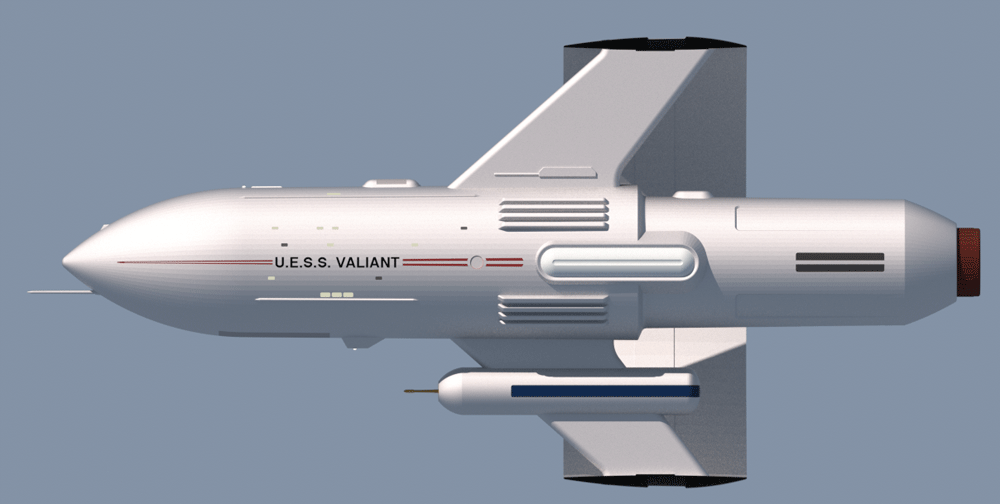
This is also where you can really see the pulp sic-fi rocketship element as the basis for the design. You have the bullet shaped main body flipped on its side and detailed grafted onto a more contemporary looking lower (or aft) booster section. The fins of the rocketship have been morphed into support struts for the space warp ring and the navigational deflector pod.
I had two thoughts about the recorder marker. One spot could have it housed in that nub hanging under the main hull just aft of the landing bay doors. There is another nub on top of the aft section not far behind the upper ring support strut. Of course it could also be housed just about anywhere else on the hull behind a hatch that's not immediately visible.
Warped9,
Thanks. Well, in that case why not have 2 recorder markers? One at each location. One that can be jettisoned in front of the ship and one that can be jettisoned behind the ship, depending on the circumstances, or possibly eject both at the same time.
Navigator NCC-2120 USS Entente
/\
Last edited:
Hey, you've probably said already, but I'm curious to know - what renderer do you use for Sketchup?
Maxwell.Hey, you've probably said already, but I'm curious to know - what renderer do you use for Sketchup?
Maxwell.Hey, you've probably said already, but I'm curious to know - what renderer do you use for Sketchup?
Easy to pick up? Backstory for why I'm asking. If you might recall, about a year ago, I was trying to get started in 3D in an old Win XP machine, where the program would run like molasses, and a decent resolution render would take hours!
Now, fast-forward to this past Christmas, and my lovely wife got me a new iMac. It's got 3D power to spare, and I'm thinking about getting into it seriously.
Especially after seeing how much creative luck you're having with SU.
Does Maxwell have any limitations, or weird quirks I should know about before trying?
The amount of work that has gone into these images is truly impressive  but I find myself unable to convince myself that the United Earth Space Ship Valiant did look like that.
but I find myself unable to convince myself that the United Earth Space Ship Valiant did look like that.
The main body reminds me too much of the space shuttle's fuel tank or a blimp, and the archaic design and outer shell of the Valiant's recorder marker suggests a closer relation to either the design DY-100 or the (unseen) DY-500. Just my humble opinion and assuming Warped9 is interested in various kinds of feedback.
Bob
 but I find myself unable to convince myself that the United Earth Space Ship Valiant did look like that.
but I find myself unable to convince myself that the United Earth Space Ship Valiant did look like that. The main body reminds me too much of the space shuttle's fuel tank or a blimp, and the archaic design and outer shell of the Valiant's recorder marker suggests a closer relation to either the design DY-100 or the (unseen) DY-500. Just my humble opinion and assuming Warped9 is interested in various kinds of feedback.
Bob
^^ The main body is actually the spaceship Friede from Woman In The Moon (1929) stretched out a bit in the nose and tapered a little. The resemblance to the shuttle orbiter's fuel tank is coincidental. And I don't think the recorder marker is really any more indicative of what the Valiant should look like than a reel-to-reel tape player indicates what a 1950's or '60's era fighter jet should look like.
Truth is I'm still learning Maxwell and slowly learning how to get more out of it. I do suggest you go for the licensed version (cost me only $99) because you get more functions out of the program as well as larger resolution images than you do with the free version.
Regarding SketchUp many have advised me that the Pro version isn't necessary because there are so many plugins available for the free version that help give you a greater diversity of tools.
I taught myself how to use SketchUp through trial-and-error and watching/reading some tutorials. Maxwell was a bit more involved to learn (I found), but again their online or pdf manuals can help you learn the tools. Another advantage is Maxwell works right within SketchUp---you don't have to export your model into another program to render it. The only quirk I've come across is that Maxwell can be a bit too high resolution in showing the facets that make up a curved surface. If you study the model in this thread (as well as models in my A Parade of Spaceships thread) you can see what I mean. One way to minimize that is (where appropriate) make curved surfaces with as many facets as possible to make the surface look smoother. I try to do this with large curved surfaces. With small curved surfaces than I use fewer sides to the curve to get fewer facets. I haven't been able to make an appreciable difference within SketchUp by increasing the angle of smoothing. Maxwell also has some lighting abilities within it that I appreciate.Maxwell.
Easy to pick up? Backstory for why I'm asking. If you might recall, about a year ago, I was trying to get started in 3D in an old Win XP machine, where the program would run like molasses, and a decent resolution render would take hours!
Now, fast-forward to this past Christmas, and my lovely wife got me a new iMac. It's got 3D power to spare, and I'm thinking about getting into it seriously.
Especially after seeing how much creative luck you're having with SU.
Does Maxwell have any limitations, or weird quirks I should know about before trying?
Truth is I'm still learning Maxwell and slowly learning how to get more out of it. I do suggest you go for the licensed version (cost me only $99) because you get more functions out of the program as well as larger resolution images than you do with the free version.
Regarding SketchUp many have advised me that the Pro version isn't necessary because there are so many plugins available for the free version that help give you a greater diversity of tools.
Similar threads
- Replies
- 482
- Views
- 28K
- Replies
- 12
- Views
- 2K
- Replies
- 3
- Views
- 308
Contest: ENTER
July 2025 Art Challenge - Suggest Your Themes!
- Replies
- 2
- Views
- 615
- Replies
- 3
- Views
- 645
If you are not already a member then please register an account and join in the discussion!

